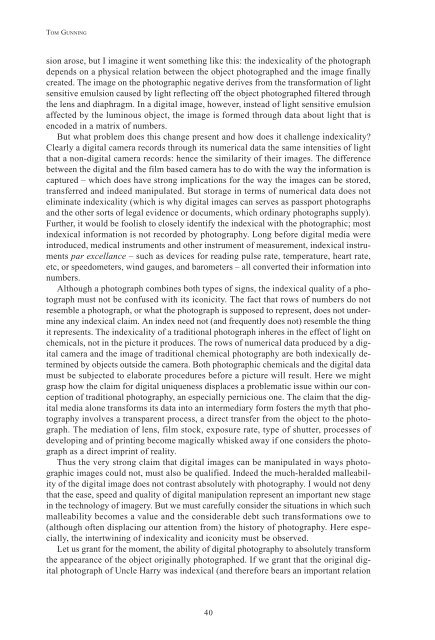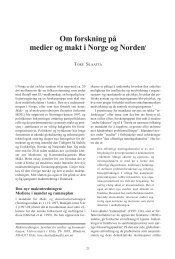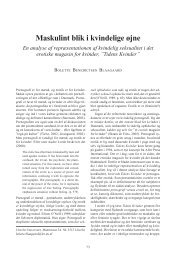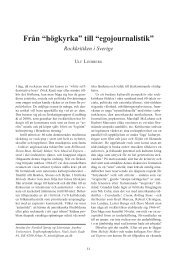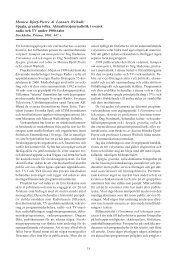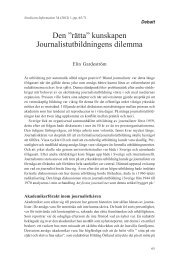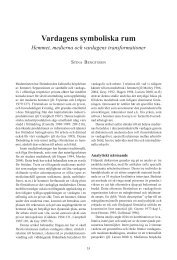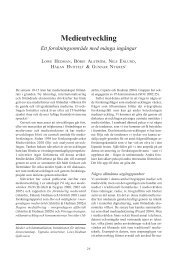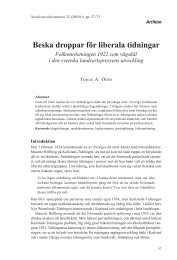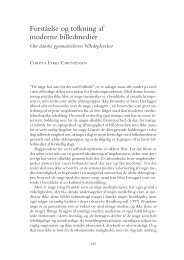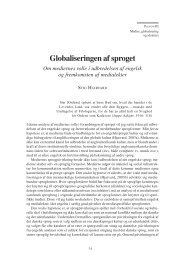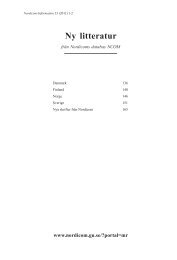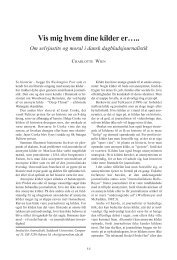What's the Point of an Index? or, Faking Photographs - Nordicom
What's the Point of an Index? or, Faking Photographs - Nordicom
What's the Point of an Index? or, Faking Photographs - Nordicom
Create successful ePaper yourself
Turn your PDF publications into a flip-book with our unique Google optimized e-Paper software.
TOM GUNNING<br />
sion arose, but I imagine it went something like this: <strong>the</strong> indexicality <strong>of</strong> <strong>the</strong> photograph<br />
depends on a physical relation between <strong>the</strong> object photographed <strong>an</strong>d <strong>the</strong> image finally<br />
created. The image on <strong>the</strong> photographic negative derives from <strong>the</strong> tr<strong>an</strong>sf<strong>or</strong>mation <strong>of</strong> light<br />
sensitive emulsion caused by light reflecting <strong>of</strong>f <strong>the</strong> object photographed filtered through<br />
<strong>the</strong> lens <strong>an</strong>d diaphragm. In a digital image, however, instead <strong>of</strong> light sensitive emulsion<br />
affected by <strong>the</strong> luminous object, <strong>the</strong> image is f<strong>or</strong>med through data about light that is<br />
encoded in a matrix <strong>of</strong> numbers.<br />
But what problem does this ch<strong>an</strong>ge present <strong>an</strong>d how does it challenge indexicality?<br />
Clearly a digital camera rec<strong>or</strong>ds through its numerical data <strong>the</strong> same intensities <strong>of</strong> light<br />
that a non-digital camera rec<strong>or</strong>ds: hence <strong>the</strong> similarity <strong>of</strong> <strong>the</strong>ir images. The difference<br />
between <strong>the</strong> digital <strong>an</strong>d <strong>the</strong> film based camera has to do with <strong>the</strong> way <strong>the</strong> inf<strong>or</strong>mation is<br />
captured – which does have strong implications f<strong>or</strong> <strong>the</strong> way <strong>the</strong> images c<strong>an</strong> be st<strong>or</strong>ed,<br />
tr<strong>an</strong>sferred <strong>an</strong>d indeed m<strong>an</strong>ipulated. But st<strong>or</strong>age in terms <strong>of</strong> numerical data does not<br />
eliminate indexicality (which is why digital images c<strong>an</strong> serves as passp<strong>or</strong>t photographs<br />
<strong>an</strong>d <strong>the</strong> o<strong>the</strong>r s<strong>or</strong>ts <strong>of</strong> legal evidence <strong>or</strong> documents, which <strong>or</strong>dinary photographs supply).<br />
Fur<strong>the</strong>r, it would be foolish to closely identify <strong>the</strong> indexical with <strong>the</strong> photographic; most<br />
indexical inf<strong>or</strong>mation is not rec<strong>or</strong>ded by photography. Long bef<strong>or</strong>e digital media were<br />
introduced, medical instruments <strong>an</strong>d o<strong>the</strong>r instrument <strong>of</strong> measurement, indexical instruments<br />
par excell<strong>an</strong>ce – such as devices f<strong>or</strong> reading pulse rate, temperature, heart rate,<br />
etc, <strong>or</strong> speedometers, wind gauges, <strong>an</strong>d barometers – all converted <strong>the</strong>ir inf<strong>or</strong>mation into<br />
numbers.<br />
Although a photograph combines both types <strong>of</strong> signs, <strong>the</strong> indexical quality <strong>of</strong> a photograph<br />
must not be confused with its iconicity. The fact that rows <strong>of</strong> numbers do not<br />
resemble a photograph, <strong>or</strong> what <strong>the</strong> photograph is supposed to represent, does not undermine<br />
<strong>an</strong>y indexical claim. An index need not (<strong>an</strong>d frequently does not) resemble <strong>the</strong> thing<br />
it represents. The indexicality <strong>of</strong> a traditional photograph inheres in <strong>the</strong> effect <strong>of</strong> light on<br />
chemicals, not in <strong>the</strong> picture it produces. The rows <strong>of</strong> numerical data produced by a digital<br />
camera <strong>an</strong>d <strong>the</strong> image <strong>of</strong> traditional chemical photography are both indexically determined<br />
by objects outside <strong>the</strong> camera. Both photographic chemicals <strong>an</strong>d <strong>the</strong> digital data<br />
must be subjected to elab<strong>or</strong>ate procedures bef<strong>or</strong>e a picture will result. Here we might<br />
grasp how <strong>the</strong> claim f<strong>or</strong> digital uniqueness displaces a problematic issue within our conception<br />
<strong>of</strong> traditional photography, <strong>an</strong> especially pernicious one. The claim that <strong>the</strong> digital<br />
media alone tr<strong>an</strong>sf<strong>or</strong>ms its data into <strong>an</strong> intermediary f<strong>or</strong>m fosters <strong>the</strong> myth that photography<br />
involves a tr<strong>an</strong>sparent process, a direct tr<strong>an</strong>sfer from <strong>the</strong> object to <strong>the</strong> photograph.<br />
The mediation <strong>of</strong> lens, film stock, exposure rate, type <strong>of</strong> shutter, processes <strong>of</strong><br />
developing <strong>an</strong>d <strong>of</strong> printing become magically whisked away if one considers <strong>the</strong> photograph<br />
as a direct imprint <strong>of</strong> reality.<br />
Thus <strong>the</strong> very strong claim that digital images c<strong>an</strong> be m<strong>an</strong>ipulated in ways photographic<br />
images could not, must also be qualified. Indeed <strong>the</strong> much-heralded malleability<br />
<strong>of</strong> <strong>the</strong> digital image does not contrast absolutely with photography. I would not deny<br />
that <strong>the</strong> ease, speed <strong>an</strong>d quality <strong>of</strong> digital m<strong>an</strong>ipulation represent <strong>an</strong> imp<strong>or</strong>t<strong>an</strong>t new stage<br />
in <strong>the</strong> technology <strong>of</strong> imagery. But we must carefully consider <strong>the</strong> situations in which such<br />
malleability becomes a value <strong>an</strong>d <strong>the</strong> considerable debt such tr<strong>an</strong>sf<strong>or</strong>mations owe to<br />
(although <strong>of</strong>ten displacing our attention from) <strong>the</strong> hist<strong>or</strong>y <strong>of</strong> photography. Here especially,<br />
<strong>the</strong> intertwining <strong>of</strong> indexicality <strong>an</strong>d iconicity must be observed.<br />
Let us gr<strong>an</strong>t f<strong>or</strong> <strong>the</strong> moment, <strong>the</strong> ability <strong>of</strong> digital photography to absolutely tr<strong>an</strong>sf<strong>or</strong>m<br />
<strong>the</strong> appear<strong>an</strong>ce <strong>of</strong> <strong>the</strong> object <strong>or</strong>iginally photographed. If we gr<strong>an</strong>t that <strong>the</strong> <strong>or</strong>iginal digital<br />
photograph <strong>of</strong> Uncle Harry was indexical (<strong>an</strong>d <strong>the</strong>ref<strong>or</strong>e bears <strong>an</strong> imp<strong>or</strong>t<strong>an</strong>t relation<br />
40


